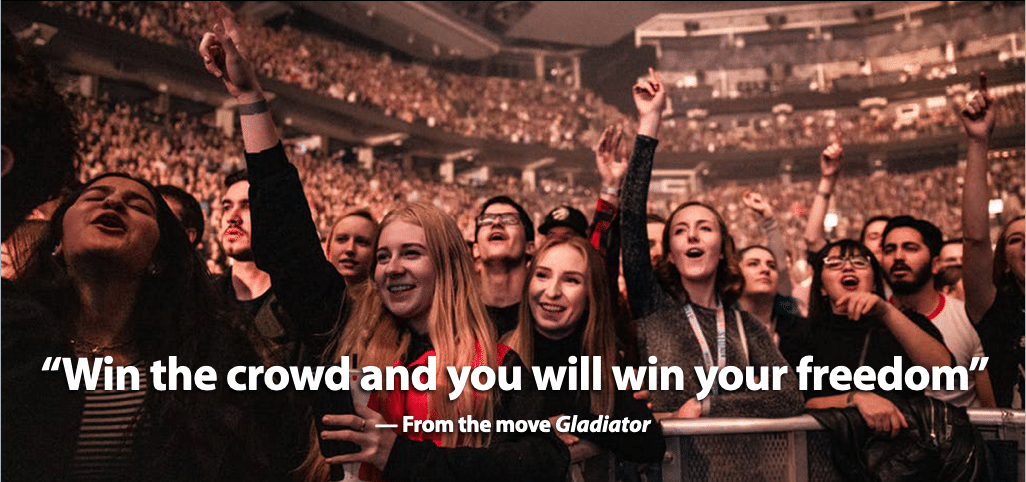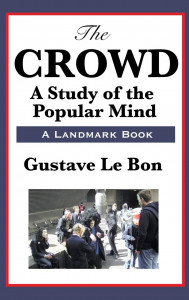
The first thing you ought to learn when crafting radio ads — or even when writing in general — is never speak or write to a crowd.
You are not making an announcement. You should be speaking to a single individual in a familiar, intimate manner.
It even helps to imagine that exact person through tools like personas or avatars.
And I mention radio because radio is an especially apt medium for intimate, one-on-one communication — if used properly.
It is, in my opinion, an ideal medium for bonding with customers by sharing your story.
Yet one of mass media’s greatest benefits springs from its ability to affect group awareness — to impact your prospective customers at the cultural level.
So it will not do to ignore the dynamics of crowd psychology when crafting your mass media advertising campaigns.
Why Speaking to the Crowd Is Important
It’s one thing for an individual to believe something; It’s another entirely for them to know that many others believe it too.
We are social creatures, and what others think and believe profoundly affects what we think and believe.
If you don’t believe that, I suggest you watch these Candid Camera experiments:
Or review this legendary Psychological Study, performed by Solomon Asch:
So while speaking intimately to your prospective customer is the first goal, you can’t afford to forget to persuade the crowd as well.
Doing both will more than double the effectiveness of your ads.
So how exactly should you do that?
August Le Bon and The Crowd
 One of the most astute works on mass or group psychology is August Le Bon’s 1895 book titled The Crowd: A Study of the Popular Mind.
One of the most astute works on mass or group psychology is August Le Bon’s 1895 book titled The Crowd: A Study of the Popular Mind.
Don’t let its publication date fool you. Everyone from investors to politicians to social scientists considers this work a must-read.
So what is it that Le Bon recommends as principle tools for persuading people as a crowd?
Allow me to quote the man himself (formatting/bullet-pointing mine):
“When, however, it is proposed to imbue the mind of a crowd with ideas and beliefs… the leaders have recourse to different expedients. The principal of them are three in number and clearly defined:
1) affirmation,
2) repetition, and
3) contagion.
Their action is somewhat slow, but [their] effects, once produced, are very lasting.”
So let’s take these tools one at a time, starting with Affirmation.
The Power of Affirmation

Let’s start by quoting from The Crowd once more:
“…It is not, then, the facts in themselves that strike the popular imagination, but the way in which they take place and are brought under notice. It is necessary that by their condensation, if I may thus express myself, they should produce a startling image which fills and besets the mind.”
“Affirmation pure and simple, kept free of all reasoning and all proof, is one of the surest means of making an idea enter the mind of crowds. The conciser an affirmation is… the more weight it carries. The religious books and the legal codes of all ages have always resorted to simple affirmation…”
“It is certain that men of immense, of almost supernatural insight, that apostles, leaders of crowds—men, in a word, of genuine and strong convictions—exert a far greater force than men who deny, who criticise, or who are indifferent…”
These quotes clarify the stark difference between an ordinary statement and an affirmation:
- They create vivid mental images in the mind (often through artistic exaggerations)
- They are concise and decisive (instead of dryly factual or logic-driven)
- They exhibit sincere, strong, and positive convictions
If that list strikes you as a cross between Brandable Chunks and We Believe Statements, you couldn’t be more right.
And if the part about exhibiting sincere, strong, and positive emotions reminds you of my previous post on ethos and thumos, you’re on the right track there as well.
It’s one thing to have the owner of the business (or spokes-character) speak to the crowd directly, in an intimate, one-on-one fashion in order to persuade customers on an individual level.
And it’s another entirely to ensure that communication is peppered with affirmations and brandable chunks aimed at influencing crowd psychology in your favor.
Especially when those chunks include earwormy sound signatures and ultra-repeatable catchphrases.
Even better is when those brandable chunks create expected patterns that can be played with and subverted for greater audience impact.
The Power of Repetition
Wizard of Ads partners are intransigent on the importance of frequency and long-term branding.
Your prospective customers must be exposed to your mass media ads at least three times per week, every week of the year, year after year, to allow the cumulative effect of repetition to work its magic.
Repetition is the alchemical secret to how you get what you say about your company in your ads to become what the proverbial “they” say about your company.
And if you doubt that, just listen to Le Bon as he explains it all in The Crowd:
The influence of repetition on crowds is comprehensible when the power is seen, which it exercises on the most enlightened minds. This power is due to the fact that the repeated statement is embedded in the long run in those profound regions of our unconscious selves in which the motives of our actions are forged.
At the end of a certain time we have forgotten who is the author of the repeated assertion, and we finish by believing it. To this circumstance is due the astonishing power of advertisements.
When we have read a hundred, a thousand times that X’s chocolate is the best, we imagine we have heard it said in many quarters, and we end by acquiring the certitude that such is the fact.
When we have read a thousand times that Y’s flour has cured the most illustrious persons of the most obstinate maladies, we are tempted at last to try it when suffering from an illness of a similar kind.
If we always read in the same papers that A is an arrant scamp and B a most honest man we finish by being convinced that this is the truth, unless, indeed, we are given to reading another paper of the contrary opinion, in which the two qualifications are reversed. Affirmation and repetition are alone powerful enough to combat each other.
But with repetition creates the risk of audience boredom and dislike.
What you need is enough variety to ensure interest and enough consistency to create repetition.
This is why great advertisers think in terms of campaigns and not single, one-off ads.
It’s also why brandable chunks are so powerful: they allow for consistency within variation.
Why? Because they allow you to:
- Mix and match chunks, rather than requiring every chunk to be used in every ad
- Change the placement of chunks within an ad, as opposed to a single tagline that always arrives at the end of an ad
- Vary the phrasing of the chunks as context and grammar requires
With brandable chunks, you get the consistency necessary to pound home a message until it sinks into the unconscious of your audience.
The Power of Contagion
Once again, I’ll begin by quoting from The Crowd:
When an affirmation has been sufficiently repeated and there is unanimity in this repetition… what is called a current of opinion is formed and the powerful mechanism of contagion intervenes. Ideas, sentiments, emotions, and beliefs possess in crowds a contagious power as intense as that of microbes…
For individuals to succumb to contagion their simultaneous presence on the same spot is not indispensable. The action of contagion may be felt from a distance under the influence of events which give all minds an individual trend and the characteristics peculiar to crowds…
Imitation, to which so much influence is attributed in social phenomena, is in reality a mere effect of contagion…
In a sense, Contagion is the next step that happens once key parts of your messaging gain social currency.
People who haven’t been directly exposed to your ads are picking up key parts of your messaging or brand positioning from those who have.
There are plenty of people who’ve never seen a De Beer’s ad touting how “A Diamond Is Forever” who’ll readily spout off the “conventional wisdom” that a diamond engagement ring should cost two month’s salary.
Just as there are plenty of drivers who know that BMW is “The Ultimate Driving Machine” who have never encountered an ad from the campaign that made that slogan famous.
And as there are plenty of consumers who instinctively think of Absolut as a premium vodka even though the campaign that established that positioning ended almost 15 years ago.
Note that contagion is more powerful than just “going viral,” as it indicates not that a given ad was shared, but that the desired persuasion embedded in your ads has been shared.
But for that to happen, your desired persuasion has to have been distilled down into vivid, repeatable chunks, and then repeated enough times to sink into the subconscious of the public.
Putting It All Together
In this sense, the three factors of crowd persuasion can be seen as a series of chronological steps:
First, you create the affirmations — aka Brandable Chunks.
Then you repeat those affirmations in the context of entertaining and memorable ads run with enough frequency and duration.
And finally, you benefit from those chunks becoming contagious bits of “traditional wisdom,” that people just “know.”
See how it all works?
Yes, we want to persuade individuals by speaking to them in a one-on-one fashion, but we also want to engage the crowd in a manner designed to create a cultural consensus of our advocated positions.
And properly designed Brandable Chunks and Earwormy Distinctive Brand Assets are key tools in making that happen.
Of course, there’s one other key for supercharging these results, one that I’ve touched on in a previous post but that I’ll explore in further detail next week.
- Are You Paying for Too Much for the Wrong Keywords? - July 15, 2024
- Dominate Your Market Like Rolex — 4 Powerful Branding Lessons - July 3, 2024
- Military-Grade Persuasion for Your Branding - June 25, 2024
